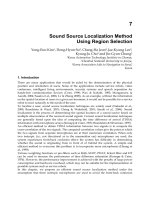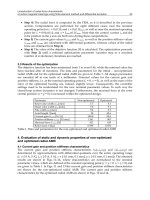Positioning Techniques in Surgical Applications - part 4 doc
Bạn đang xem bản rút gọn của tài liệu. Xem và tải ngay bản đầy đủ của tài liệu tại đây (2.08 MB, 33 trang )
Chapter 7 · Technical equipment86
7
Operation accessory stand, mobile. With standard rails
and wire baskets for positioning aids and small parts.
7.2.3 Extension table accessories
Sliding rail extension. Extends the lateral rail, e.g. at the
extension operating table (
. Fig. 7.68).
Countertraction post. For supine positioning of the pa-
tient when performing surgery to the lower extremities.
Fitted to the right or left bore of the cross bar at the end of
the seat plate or extension table patient board. The counter-
traction post is fitted to the fractured side (
. Fig. 7.69).
Extension bars. For variable adjustment of the length when
performing surgery to the lower extremities and to accom-
modate the spindle unit or foot plates. Standard accessories
for extension tables always include a long and short exten-
. Fig. 7.67. Knee positioning device, manual
. Fig. 7.68. Rail extension
. Fig. 7.69. Countertraction post
. Fig. 7.70. Extension bars, short and long
. Fig. 7.71. Spindle unit
7
87
sion bar. The short extension bar (black cap) can always be
fitted to the fractured side (
. Fig. 7.70).
Spindle unit. Adjusts the extension length with a hand
crank, with ball joint for anatomically correct alignment
of the fractured extremity (
. Fig. 7.71).
Foot plate support. To support the non-fractured extrem-
ity with positioned foot plate (
. Fig. 7.72).
Rotation tilt clamp. Accommodates foot plates (extension
shoes) for extensions to the lower extremities or Weinber-
ger wristlets for hand/arm extensions (
. Fig. 7.73).
Rotation bar clamp. Accommodates the extension bar
(
. Fig. 7.74)
Foot plate for extension table. Fixes the patient’s foot to
the spindle unit or foot plate support, possibly with rota-
tion tilt clamp; can be adjusted in width to various foot
sizes (
. Fig. 7.75).
Lower leg countertraction post. For positioning the frac-
tured lower leg with CRP countertraction post and hori-
zontal guide pipe for an extension bar (
. Fig. 7.76).
. Fig. 7.72. Foot plate support
. Fig. 7.73. Rotation tilt clamp
. Fig. 7.74. Rotation bar clamp
7.2 · Positioning accessories and aids
. Fig. 7.75. Foot plate for extension table
Chapter 7 · Technical equipment88
7
and ventral cervical spine in patients with halo fixator
(
. Fig. 7.80).
Motor-driven knee positioning unit. The surgeon con-
trols the electric knee positioning unit with a foot switch
to facilitate the necessary bending and stretching move-
ments particularly during knee replacement surgery
(
. Fig. 7.81).
7.2.5 Vacuum mats
In various sizes for firm positioning of the patient through
good distribution of pressure (
. Fig. 7.82).
. Fig. 7.76. Lower leg countertraction post
Special leg plates for hip replacement. For positioning a
patient in the supine position on the extension table,
providing good access for the image intensifier to both
hips (
. Fig. 7.77).
Accessories stand. Accommodates extension table acces-
sories (
. Fig. 7.78).
7.2.4 Special units
Motor-driven headrest adjustment. Guarantees anatomi-
cally correct upwards and downwards movement of the
horseshoe headrest/headrest to prevent compression and
extension of the cervical spine. Motor adjustment in a
range from +25 to -35°. Controlled by a separate foot switch
so that the surgeon can sit to perform the procedure
(
. Fig. 7.79).
Spinal support unit/head extension. For intraoperative
repositioning and fixing for operations to the dorsal
. Fig. 7.77. Special leg plates
. Fig. 7.78. Accessories stand
. Fig. 7.79. Motor-driven headrest adjustment
7
89
. Fig. 7.80. Spinal support unit
. Fig. 7.81. Motor-driven knee positioning unit
7.2 · Positioning accessories and aids
. Fig. 7.82. Example of use
Chapter 7 · Technical equipment90
7
. Fig. 7.83. Example of use
7.2.6
Patient warming system
The basic idea. Before surgery, it is decided which parts of
the body can be covered without impairing the surgical
activities. Heat is supplied from above (conductive meth-
od). The patient is covered outside the surgical/sterile
area. Highly versatile, segmented and specially shaped
blankets are ideal for individual use in every surgical dis-
cipline (
. Fig. 7.83).
8
8 Standard positioning
D. Aschemann, A. Gänsslen
8.1 Introduction – 92
8.2 Preparation of the operating table – 92
8.2.1 Universal operating table Alphamaquet 1150.30
with water and gel mat for trauma surgery – 92
8.3 Supine position – 93
8.3.1 Head – 93
8.3.2 Shoulders and arms – 93
8.3.3 Back and pelvis – 94
8.3.4 Legs – 95
8.4 Lithotomy position – 96
8.4.1 Head, shoulders and arms – 96
8.4.2 Back and pelvis – 97
8.4.3 Legs – 97
8.5 Beach-chair position – 98
8.5.1 Head – 98
8.5.2 Shoulders and arms – 99
8.5.3 Back and pelvis – 99
8.5.4 Legs – 99
8.6 Prone position – 99
8.6.1 Head – 100
8.6.2 Arms – 100
8.6.3 Thorax and pelvis – 102
8.6.4 Legs – 102
8.7 The lateral position – 102
8.7.1 Head – 103
8.7.2 Shoulder and arms – 103
8.7.3 Thorax and pelvis – 104
8.7.4 Legs – 104
8.8 Final remarks – 105
Chapter 8 · Standard positioning92
8
8.1 Introduction
Avoiding pressure sores at the back of the head, at the
shoulder blades, the coccyx and the heels are just as much
a priority in preparing the operating table as positioning
the patient so as to protect the nerves in the following
steps. In the case of longer procedures or for intensive
care patients with long stays in hospital, these are the
parts of the body where bedsores can occur. The sequence
in which protective and positioning materials are used to
cover the operating table is directly related to care, safety
and the operative procedure. Negligence in preparing the
operating table and incorrectly performed positioning
procedures will have a negative effect on the patient al-
ready during the operation.
8.2 Preparation of the operating table
8.2.1 Universal operating table
Alphamaquet 1150.30 with water
and gel mat for trauma surgery
An X-ray mat is placed on the operating table from the
buttock plate to the headrest when permitted or required
by the surgical procedure (X-ray protection against radi-
ation from imaging equipment from below, here image
intensifiers,
. Fig. 8.1).
The leg plates are not used for trauma surgery, as some
procedures require the removal or lifting/lowering of a leg
plate. Depending on the duration and type of procedure,
the operating table can be prepared with a short water mat
(e.g. 55×100 cm) with the mat always connected at the
head end so that the C-arm can be moved without any
problems in the scanning area and to provide better access
to the patient in general (
. Fig. 8.2). But generally the pa-
tient should always be warmed from above with a patient
warming system (conductive method).
A short gel mat (e.g. 60×100 cm) is positioned to
cover the water mat and, in turn, not cover the leg plates
(
. Fig. 8.3).
A paper sheet with water barrier is spread as insulati-
on over the complete operating table. A folded 120-cm
fabric sheet is placed on the absorbent layer of the paper
sheet and a neutral electrode is placed on the fabric sheet.
All layers end flush with the edge of the table and the folds
are smoothed down (
. Figs. 8.4, 8.5).
It is also possible to use the gel mat as final cover on
the operating table, so that the patient’s body is in direct
contact with the gel mat.
. Fig. 8.1. Universal operating table with X-ray protection
. Fig. 8.2. Water mat with connection at head end
. Fig. 8.3. Gel mat for safe positioning of the patient
. Fig. 8.4. Paper sheet with water barrier and fabric sheet
8
93
The number of additional layers between the patient
and the operating table or padding should be reduced
as far as possible as this otherwise limits usefulness and
it is no longer possible to prevent bedsores (
. Fig. 8.6).
8.3 Supine position
8.3.1 Head
In the supine position, the head must be padded with va-
rious positioning aids so that the cervical spine is in the
middle/neutral position (awake) and there is no local
pressure on the back of the head (
. Figs. 8.7–8.9).
8.3.2 Shoulders and arms
Normally in general surgery, both of the patient’s arms are
spread out to the side. For pronation positioning, the
spread arms should be put into abduction to approx. 60°
bent at the elbows, and positioned and fixed with the
lower arm on the arm positioning device. Support, for ex-
ample with a short armrest, should always be provided for
. Fig. 8.6. Pressure marks from sheets and tubes
. Fig. 8.5. Positioning aid (double wedge cushion and half-roll)
. Fig. 8.9. Double wedge cushion with padding under the shoulders
. Fig. 8.7. Closed head ring
. Fig. 8.8. Gel head cushion
8.3 · Supine position
. Fig. 8.10. Correct arm positioning with short armrest
Chapter 8 · Standard positioning94
8
the lower arm and hand. This positioning of the arm pre-
vents the so-called wristdrop (
. Figs. 8.10, 8.11).
For abduction of the arm between 60° and 90°, the
patient should always be adjusted from pronation to supi-
nation position (Texas position). A pad can be placed
under the wrist in this position (
. Figs. 8.12, 8.13).
The nerves in the elbow must lie free of pressure. Pad-
ding under the shoulder consisting of a special double
wedge pad, gel pad or a 250/500 ml infusion bag raises the
shoulder from the level of the table and enlarges the gap
between clavicle and first rib, with a clear reduction in the
risk of harming the nerves. The arm must be lifted over
the level of the shoulder (
. Fig. 8.14).
The rule of thumb for positioning the arm in supine pa-
tients is as follows: place pads under the shoulder to lift
it from the level of the table, with the distal joint higher
than the proximal joint.
So the elbow is higher than the shoulder and the wrist
higher than the elbow. The arm can be positioned at the
body (e.g. heart surgery) using an arm holder (
. Figs. 8.15,
8.16
).
8.3.3 Back and pelvis
Hips and knees should be preferably slightly bent; pads
should be placed under the frequently exposed lumbar
spine. The pads can consist of a small pile of cellulose, a
small rolled/folded towel or an additional small gel pad.
The thickness and position of the padding depends on
. Fig. 8.11. Incorrect arm positioning, dropped wrist
. Fig. 8.12. Positioning the arm on short arm positioning device in
abduction
. Fig. 8.13. Abducted arm with padding, fixed on a long arm positio-
ning device
. Fig. 8.14. Head and arm positioning with double wedge cushion
. Fig. 8.15. Arm positioning with arm protection
8
95
the patient. The padding is placed under the top surface
of the operating table (e.g. gel mat) so as not to interrupt
the homogeneous top surface and impair its effect. If no
positioning aids are available, the operating table should
be adjusted to support parts of the body which are not flat
on the table (
. Figs. 8.17–8.19).
8.3.4 Legs
If necessary, a half roll is placed under the knees at the
distal thigh. Another possibility is to adjust the leg plates
at the knee joint. Pressure on the heels should always be
reduced to a minimum.
. Figure 8.20 shows increased
pressure on the heels with the use of a gel mat. One pos-
sibility is to use small gel mats placed under the lower leg
(
. Fig. 8.21). But the leg should always have the greatest
possible contact with the patient board with every kind of
padding. These requirements can also be fulfilled by using
a vacuum mat, as in
. Figs. 8.19 and 8.22.
. Fig. 8.16. Hand and elbow are protected
. Fig. 8.17. Positioning without positioning aids and straight oper-
ating table
. Fig. 8.20. Increased pressure on the heels
. Fig. 8.18. Positioning without positioning aids with adapted adjust-
ment of the operating table
. Fig. 8.19. Positioning with vacuum mat and operating table in
Trendelenburg position and tilted to the left
8.3 · Supine position
. Fig. 8.21. Reduced pressure with clearance of the heels
Chapter 8 · Standard positioning96
8
8.4 Lithotomy position
8.4.1 Head, shoulders and arms
In the lithotomy position, shoulder supports are used in
addition to position the head. Once again, the head should
be held in the middle/neutral position (
. Figs. 8.23, 8.24).
The patient should be prevented from slipping if Tren-
delenburg positioning is required. It is also important to
avoid a low position of the clavicle and to minimise pres-
sure at the contact points, because not even well padded
shoulder supports can always avoid damage to the plexus
(
. Fig. 8.25).
A short vacuum mat should always be used in this posi-
tion as a standard procedure for longer operations or if
required by the patient’s size. This distributes the pres-
sure across the back and relieves the pressure on the
shoulders.
But if the patient is positioned as shown in . Fig. 8.26, it is
possible for the patient to slip in the Trendelenburg posi-
tion. Without any positioning aids, the head has landed on
an ECG lead. These »trifles« can lead to the onset of skin
injuries.
. Fig. 8.22. Reduced pressure with clearance of the heels using a va-
cuum mat
. Fig. 8.24. Positioning with gel head ring and shoulder supports
. Fig. 8.23. Lithotomy position with Goepel leg holders
. Fig. 8.25. Positioning with vacuum mat and operating table in Tren-
delenburg position
8
97
8.4.2 Back and pelvis
Special attention and care is required when positioning
the pelvis/sacrum. Excessive warmth from water mats
and local loads on the sacrum will encourage the devel-
opment of pressure sores. Here again, the vacuum mat
can be used as a suitable precaution, because the mat
moulds itself to the whole back region, distributing the
contact pressure which is thus also reduced at the ex-
posed regions of the back. A dimpled gel mat with direct
body contact can be beneficial for this kind of positioning
because it distributes the contact pressure better. Fur-
thermore, a drainage effect is achieved in case the drapes
are inadequately adhered, so that the buttocks do not
have to lie in disinfectants and body fluids.
8.4.3 Legs
The legs are normally positioned in Goepel leg holders
(
. Figs. 8.23, 8.28). Another possibility is to use modern
pneumatic leg holders with well padded calf boots (
. Figs.
8.25, 8.27, 8.29 and 8.30
). These leg holders are recom-
mended for longer operations, because the pressure is on
the soles of the feet and less on the calves. Another version
is to position with feet in leg holders with removable heel
loops.
It is ideal if the leg holders are fitted at the level of the
hip joint to prevent the patient from slipping on the ope-
rating table if the legs are moved. The end of the foot and
knee of a leg should form an axis with the opposite shoul-
der. Unfortunately, compartment syndrome of the lower
leg is not rare after an operation lasting several hours in
the lithotomy position. Repeated, regular movement of
the legs (not massage) during the operation by an assis-
tant would help to prevent positioning complications and
also reduce the risk of an embolism. Here it is sufficient to
. Fig. 8.26. Patient slides down the operating table with head lying
on the ECG cable
. Fig. 8.27. Comfortable leg and back positioning
. Fig. 8.28. Incorrect positioning of the leg in the Goepel holder, wit-
hout padding and with pressure on the head of the fibula
8.4 · Lithotomy position
. Fig. 8.29. Positioning the legs in special leg holders
Chapter 8 · Standard positioning98
8
apply slight pressure to the sole of the foot to relieve the
calf briefly.
8.5 Beach-chair position
Three versions of the beach-chair position are common
practice.
To prepare the operating table for the first version, it is
sufficient to provide an operating table (here Maquet 1120
position II), but definitive positioning of the patient is
time consuming, and requires physical effort and commit-
ment on the part of the staff. After consulting the anaes-
thetist, the patient is positioned head-down on the fitted
horseshoe headrest. After placing suitable positioning
pads under the patient’s buttocks (here: wedge and block
pads depending on the patient’s size), the operating table
is brought gradually into the half-sitting position. The
back plate is raised alternately with a low head movement
of the whole operating table until the final position is
reached. At the same time, the patient is pushed right over
onto the operating side until the patient’s side is on the
edge of the table. Finally the leg plates are adjusted manu-
ally and the head is fixed.
Replacing the leg plates for a special shoulder plate in
Maquet 1120 position I results in the second possibility for
a sitting/half-sitting position. The operating table is ad-
justed by electromechanical means using the remote
control. In this version, the positioning aids are already
completely fitted to the table. The patient has been arranged
in position and the table can be adjusted as usual until the
final position is reached. It is rarely necessary to use posi-
tioning aids (wedge and block pads). In this case, the
shoulder is exposed by removing a shoulder segment. This
version involves minimum personnel and physical effort
and takes up a minimum of time.
The third version is described here for the universal ope-
rating table 1150.30. The operating table is equipped with
the shoulder plate component before the patient is brought
into the operating suite. Once again, it is not necessary to
fit additional positioning aids to the operating table, and
the patient is already arranged with head and shoulders in
position. After starting the anaesthetic and moving the pa-
tient board onto the operating table column, the patient
board is aligned so that the operating side points towards
the instrument nurse. To support sturdy, firm positioning,
the buttocks are moved to the outer edge of the seat plate.
The operating table can also be moved to the opposite side
with the tilting function. There should therefore not be any
protruding pins in the area of the seat plate bars to fasten
operating table pads (
. Fig. 8.31).
8.5.1 Head
The distance between horseshoe headrest and the head
end of the operating table depends on the patient’s size.
The head and cervical spine are positioned in the middle/
neutral setting. The head should no longer be fixed and
held to the horseshoe headrest with wide transparent plas-
ters over the forehead. Today the head can be positioned
comfortably in a helmet with special padding for the cer-
vical spine and secured with a padded belt across the fore-
head (
. Fig. 8.32).
. Fig. 8.30. Diagram to show positioning of the legs in the lithotomy
position
. Fig. 8.31. Beach-chair position
8
99
8.5.2 Shoulders and arms
In the end, the patient should be positioned to give the
surgeon suitable, free access to the operating site by re-
moving the shoulder plate segment. If necessary, the
arm can be positioned with abduction if required for
the anaesthetic. On the operating side, the arm is usually
positioned directly at the body (
. Fig. 8.33).
8.5.3 Back and pelvis
In this position, the upper body does not lie with its full
weight on the back plate of the operating table but also
puts pressure on the pelvis and thighs. Special attention
must be given to distributing the contact pressure in this
area. A thorax support can provide the patient with addi-
tional support on the side (
. Figs. 8.34, 8.35).
8.5.4 Legs
If necessary, a half roll is placed under the knees at the
distal thigh. In other cases, a wedge pad can also be placed
under the thighs. Pressure on the heels should always be
reduced to a minimum, depending on the planned opera-
tion. One possibility is to use small gel mats placed under
the calf. But the leg should always have the greatest pos-
sible contact with the patient board with every kind of
padding (
7 see also Sect. 8.3.4).
8.6 Prone position
The patient is placed under anaesthetic while still supine
and rolled into the operating theatre still supine. In the
operating theatre, the arm positioning devices are brought
into position and the patient is turned over onto the abdo-
. Fig. 8.32. Helmet for sitting position
. Fig. 8.33. Shoulder positioning with segment removed
. Fig. 8.34. Beach-chair position with thorax support
. Fig. 8.35. Thorax support
8.6 · Prone position
Chapter 8 · Standard positioning100
8
men by at least four persons. The positioning aids are fit-
ted in posi
tion.
Before placing the head on the positioning aid, padding
must be placed under the thorax!
But the procedure for changing the patient’s position can
be much simpler for everyone involved by preparing a
second operating table with the corresponding position-
ing aids, adjusting it in height to be lower than the first
operating table, and the patient is then rolled over into the
prone position (
. Figs. 8.36, 8.37).
In any case it is important to consult the anaesthetist
to ensure that IV drips and monitoring leads (ECG) are
secured or, preferably, disconnected while repositioning
the patient.
8.6.1 Head
In the prone position, the head must be arranged using
various positioning aids so that the cervical spine is in the
middle/neutral position (awake,
7 see. Figs. 8.38–8.41).
8.6.2 Arms
Both arms are lowered about 30° in the shoulder and
brought forward by max. 90° with a bend of about 90° at
the elbow. The lower arms are placed on the arm posi-
tioning devices, ensuring that the elbows are free (for
short arm supports) or well padded (
. Fig. 8.47). The
patient’s upper arms must not be positioned at the lateral
edges of the operating table (incorrect arm positioning
. Figs. 8.42–8.45).
The rule of thumb for positioning the arms in the prone
position:
Position the distal joint of the arm lower than the proxi-
mal joint.
. Fig. 8.37. Prone position on the CRP operating table
. Fig. 8.38. Head position on dimpled foam cushion
. Fig. 8.39. Head position on gel cushion
. Fig. 8.36. Operating table with positioning aids ready in position
8
101
. Fig. 8.40. Head position on gel cushion
. Fig. 8.41. Head position on one-piece horseshoe headrest
. Fig. 8.42. Incorrect arm positioning. The arm is raised too high on
the short armrest with dropped wrist
. Fig. 8.43. Incorrect arm positioning. The arm is raised too high on
the short armrest with dropped wrist
. Fig. 8.44. Incorrect arm positioning, dropped wrist and unfavourable
position of the shoulder
8.6 · Prone position
. Fig. 8.45. Incorrect arm positioning, dropped wrist and unfavourable
position of the clamps
Chapter 8 · Standard positioning102
8
This means the elbow is lower than the shoulder and the
wrist lower than the elbow (
. Figs. 8.40, 8.46, 8.47).
8.6.3 Thorax and pelvis
The thorax and pelvis are raised using suitable position-
ing pads so that the abdomen is free and the patient’s
breathing is not affected. It is important that the pelvic pad
does not to squash the blood vessels in the groin (vena
cava syndrome). The dimensions for the positioning pads
depend on the patient’s size (
. Fig. 8.48).
8.6.4 Legs
The patient’s knees and feet are positioned with protection
from pressure sores by placing a wide wedge pad, roll and,
if necessary, small gel mat under the knees (
. Fig. 8.49).
. Fig. 8.47. Arm positioning to protect the nerves and optimum
shoulder position on the arm positioning device
. Fig. 8.46. Safe arm position and ideal shoulder position
. Fig. 8.48. Abdominal position on 4 special bolsters
. Fig. 8.49. Leg positioning with wedge cushion and roll
8.7 The lateral position
Version without vacuum mat.
The patient is placed under
anaesthetic while still supine and rolled into the operating
theatre still supine
. The arm positioning device on the side
not being operated is positioned at an angle of 90° to the
operating table. A Goepel leg holder is fitted to the rail of
the headrest using a radial adjustment clamp, this is for
the upper arm. The patient is brought into the lateral po-
sition using kinesiology (
. Fig. 8.50).
Version with vacuum mat. The vacuum mat is mould-
ed to the body of the patient in the lateral position, then
the air is withdrawn from the mat with a surgical suction
unit or special pump. This means the patient is now lying
in a bed fitted to his body shape. If before extracting the
air a side support is fitted for safety reasons to either side
on the level of the sacrum and symphysis if the operating
table is expected to tilt to the side, as far as possible the
support should not be in contact with the patient but sup-
port the vacuum mat (
. Fig. 8.51).
8
103
8.7.1 Head
The operating table headrest is adjusted in such a way that
the patient’s head is positioned with the spinal column in
a straight neutral position in the area of the lower cervical
spine. Another version is to use a gel ring as additional
padding for the head (
. Figs. 8.52, 8.53).
8.7.2 Shoulders and arms
The lower arm is pulled forwards slightly and placed on
the arm support device which stands at an angle of 90° to
the operating table and reaches up to the table. The upper
arm is abducted maximum 90° in the shoulder and posi-
tioned with the lower arm and slightly bent elbow on the
Goepel leg holder. Both arms are padded with small gel
mats (
. Fig. 8.54).
. Fig. 8.50. Lateral position
. Fig. 8.51. Lateral position with vacuum mat
. Fig. 8.52. Positioning the patient on a special cushion for lateral
position
. Fig. 8.53. The left ear is kept free with a gel ring
8.7 · The lateral position
. Fig. 8.54. Maximum 90° abduction of the arms with shoulders
moved forwards
Chapter 8 · Standard positioning104
8
8.7.3
Thorax and pelvis
A foam or gel roll is pushed under the lower thorax side to
relieve the shoulder. The special pad for the lateral position
cushions the thorax to a large extent and supports the
lower arm and shoulder with a padding effect (
. Fig. 8.55).
The pelvis is supported with two side supports at the
symphysis and sacrum. For operations to the lower extre-
mities, the side supports are fitted to the rails of the lower
back plate or seat plate from the head end, and for lateral
thoracotomy, retroperitoneal access or procedures to the
vertebral column, from the foot end, (
. Fig. 8.56).
8.7.4 Legs
A tunnel cushion is positioned between the legs to prevent
pressure sores. By using the tunnel cushion, the weight of
the upper leg does not impair the position of the lower leg.
One or two body belts fix the positioning of the legs and
pads (
. Fig. 8.57).
. Fig. 8.55. Padding under the thorax and positioning of the lower
arm and shoulder so as to provide relief
. Fig. 8.56. Support for shoulder and sacrum
. Fig. 8.57. Tunnel cushion, patient safeguarded with body belt
. Fig. 8.58. The surgical nurse is leaning on the patient’s left knee
. Fig. 8.59. The surgeon is leaning on the patient’s left knee
8
105
. Fig. 8.60. A satisfied patient after the operation
8.8 Final remarks
It is not only the standard positioning procedures, our
positioning know-how and the positioning aids which
protect the patient from positioning injuries. The oper-
ating team must be disciplined in continuing to support
the prophylaxis measures during the operation. Frequently
one of the team members will lean on the patient’s knee
without realising it. The patient in
. Figs. 8.58 and 8.59 has
not been supported by a half roll under the knee. Here the
left knee is straightened with increased pressure on the
heels. Neither is it necessary for the instruments to lie on
the legs.
Our aim is for the patient to be satisfied after the ope-
ration, having been well padded by the team during the
operation, and kept in a dry, warm position (
. Fig. 8.60).
8.8 · Final remarks
9
9 Function workflow in the operating
suite
D. Aschemann, A. Gänsslen, L. Mahlke
9.1 Standard steps in the elective programme – 108
9.1.1 Patient reception – 108
9.1.2 Selection of the operating table and placing the patient on it – 108
9.1.3 Preparation of the patient in the anaesthesia induction room – 108
9.1.4 Definitive positioning – 109
9.1.5 Preparing the bed and measures at the end of the operation – 109
9.2 Preparations in an emergency (under time pressure) – 110
9.3 Preparations for open fractures – 110
Chapter 9 · Function workflow in the operating suite108
9
9.1 Standard steps in the elective
programme
Preparation of the patient for the planned operation
begins on making the indication and planning the date.
Special implants or special positioning aids, for example a
cervical spine holder, must be ordered in plenty of time
and be available in time for the operation, and be sterilised
if necessary.
In our own procedures, it has become established
practice for the medical director/senior doctor to check
the indication on the day before the operation (preferably
before informing the patient), with corresponding instruc-
tions for the operating nurse/orderly who is on duty with
regard to the expected positioning (including position
aids) or additional materials required (e.g., special im-
plants, imaging intensifier, Iso-C3D). If necessary, the side
being operated will also be indicated (for operations to the
extremities or when there are two organs).
About 10–20 min before being called to the operating
suite, the ward staff administer the patient’s premedica-
tion and the transport staff bring the patient to the oper-
ating suite, bringing all the files with the findings and
necessary X-ray pictures. It is normally not necessary to
wash the patient at this point because as a rule, this will
already have been done by the patient or nursing staff on
the ward. The patient is wearing disposable pants and a
surgical gown.
9.1.1 Patient reception
On arriving in the patient sluice, the patient is welcomed
by the operating staff. Firstly unambiguous identification
of the patient is checked verbally or according to the files.
If this is not possible, a person must be called to identify
the patient. The records of the surgeon and anaesthetist
informing the patient about the procedure are checked for
the patient’s written documented consent before moving
the patient. While the patient is still awake, the side being
operated should be checked according to the operating
schedule. If the patient is not conscious, this is checked
together with the operating surgeon.
9.1.2 Selection of the operating table
and placing the patient on it
The operating table and required positioning aids are
chosen according to the kind of procedure and the special
aspects clarified before the operation (
7 see Sect. 9.1).
The patient’s bed and the operating table are adjusted
to the same height. The patient can now either slide over
onto the operating table from his bed; he should not have
to stand up to do so, because the premedication can cause
orthostatic problems (e.g. circulatory collapse). Neither
should the patient suffer from unnecessary pain during
the transfer, to ensure that the anaesthetic can be started
gently.
On the other hand, the patient can be moved with a roll
board or patient transfer system. This method should be
given preference in the case of instable, painful conditions.
Well instructed staff are vital in both cases (
. Fig. 9.1).
9.1.3 Preparing the patient in
the anaesthesia induction room
In the anaesthesia induction room, the patient is placed
under anaesthetic. While the patient is being prepared by
the team of anaesthetists, the positioning aids are put at the
ready. After intubation or completion of the local anaes-
thetic, work starts to prepare the patient for the operation.
If necessary the disposable underwear is removed (e.g. hip
operation). General body hygiene has already been com-
pleted on the ward. If necessary, the operating site can be
cleaned again in the anaesthesia induction room. This is
always the case after removing any bandages or plaster
casts and in the case of dirty operating sites, for example in
the case of open injuries. If the patient has to be shaved in
the incision area and area for applying the neutral elec-
trode, this is carried out with a dry, sparse procedure after
placing an absorbent disposable cloth underneath. After
replacing the cloth, the operating site is washed with a
washing lotion and then dried with pads. The operating site
is then rubbed with alcoholic disinfectant and covered with
a sterile drape. Any necessary tourniquet can be applied
now, taking great care to ensure that no residual moisture
. Fig. 9.1. Patient transfer system
9
109
collects under the tourniquet. The neutral electrode is only
applied after completing the definitive positioning proce-
dure!
9.1.4 Definitive positioning
After moving into the operating theatre, the operating
table is positioned on the column, the transporter remov-
ed from the theatre and the table brought to its final
position (e.g. for surgery to the arm: operating table positio-
ned crosswise in the room). Having made all positioning
aids and accessories for special positioning available in
advance, work can now begin promptly on positioning of
the patient (
. Fig. 9.2).
The definitive positioning is brought to its conclusion
with application of the neutral electrode and connecting
up to the HF surgery device, connecting the tourniquet to
the pressure gauge, applying adhesive drapes for prepara-
tion of the operating site and, if necessary, replacing the
absorbent sheet under the extremity to be washed. The
. Fig. 9.2. Definitive positioning of the patient
. Fig. 9.3. Patient warming system
. Fig. 9.4. Skin disinfection
. Fig. 9.5. Handing over the washed extremity
patient is always covered with warm drapes or, at the latest
in this preparatory phase, with a patient warming system
(
. Fig. 9.3).
The operating lights are positioned so that the sterile
light handles can be plugged in quickly.
Skin disinfection by the surgeon must take place with
the extremity held up high (
. Fig. 9.4).
After disinfecting the skin, the operating site is co v-
ered correctly by several persons in sterile clothing,
or a washed extremity is handed over to sterile staff
(
. Fig. 9.5).
The operation can begin (
. Fig. 9.6).
9.1.5 Preparing the bed and measures at
the end of the operation
Meanwhile the equipment for postoperative positioning
of the patient is placed at the ready. The bed is chosen
according to the patient’s size. There is a choice between
standard beds, children’s beds, cots or intensive care beds,
9.1 · Standard steps in the elective programme
Chapter 9 · Function workflow in the operating suite110
9
with bed extensions, extension devices or special rails
which can be fitted if necessary. It has become indispen-
sable practice to heat the bed for the patient after the ope-
ration using an electric blanket.
At the end of the operation, a sterile bandage is applied
by the operating team, the patient is disconnected from
the HF surgery device and any other connections are re-
moved (e.g. tourniquet). Disposable or multiple use covers
are disposed of in the normal containers. If necessary,
postoperative X-rays are taken to allow for possibly neces-
sary surgical corrections before bringing the patient
round after the anaesthetic. For extubation, the patient is
moved from the definitive positioning back into the su-
pine position, and the extremities are held with body belts.
It has proven effective to place the arms parallel to the
body on the arm positioning supports in this phase. The
patient can be extubated in the operating theatre or in the
post-anaesthesia room to keep the circulation concept
working in the surgical department.
If necessary, a postoperative plaster cast can be ap-
plied before the patient leaves the operating suite; for hy-
giene reasons, this should not be done in the operating
theatre itself.
The patient is transferred to a preheated bed in the
patient sluice by the surgeon and anaesthetist together. To
do so, the bed is raised to the level of the operating table.
Depending on the positioning and kind of anaesthetic, the
patient should be transferred by sliding onto the roll
board or using a patient transfer system, by rolling from
the prone directly into the supine position on the bed or
by the patient sliding over on his own. It is up to the sur-
geon to ensure that any peripheral drips, drainage tubes
and thorax drains are securely positioned, even if the pa-
tient transfer phase consists of team work. The patient is
placed in the middle of the bed without any contact with
the edges. Any positioning cushions or rails are fitted and
the drainage containers fixed to the outside of the bed. In
the case of freshly extubated patients, padded side bars
should be fitted to the bed initially and the patient should
be monitored constantly.
The patient is then brought to the recovery room or
intensive care station. In exceptional cases with regional
or local anaesthetic, the patient can also be brought
straight to the normal ward.
9.2 Preparations in an emergency
(under time pressure)
Time and again situations occur where the patient’s life
can only be saved by acting immediately and starting to
operate without delay, for example massive haemorrhag-
ing, circulatory instability or resuscitation. These situa-
tions frequently demand improvisation because the nor-
mal planned procedure would take too long. Here it is
important to weigh up the various risks to obtain the best
outcome in each specific situation.
Fundamentally, an operating table prepared with a
water mat or electric heating mat should always be at the
ready in every operating department. The vital problem of
cooling down can be reduced at least by the use of a heat-
ing mat or moving mat for operating tables. Recently,
disposable covers with circulating hot air have proven ef-
fective on the non-operated regions. Similarly, a neutral
electrode should also always be ready on the operating
table for immediate application. Depending on the expec-
ted emergency operation, the possibility of having to re-
bed the patient during the operation must be considered.
Even under time pressure, a minimum level of periopera-
tive safeguards should always be provided, to prevent the
patient from falling off the table, to avoid further damage
from pressure sores, etc.
Management is defined by the operating surgeon,
who stipulates the scope and sequence of the surgical
procedure in consultation with other disciplines (e.g.
anaesthetist) even under time pressure. Typical operation
preparations are usually carried out parallel to diagnosis,
anaesthetic preparations, transport and transfer to the
operating table.
Immediately before the operation begins, the oper-
ating site is prepared quickly but thoroughly (depilation,
washing) while the surgeon disinfects his hands. But it
does happen that such measures have to be omitted com-
pletely.
9.3 Preparations for open fractures
The patient with an open extremity fracture is usually
brought into the operating suite with a lying splint (e.g.
air chamber splint). Usually sterile bandages have already
been applied to the wound by the emergency doctor
(
. Fig. 9.7).
. Fig. 9.6. At the end of the sterile covering phase









